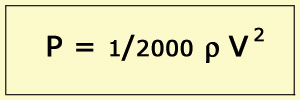

Pyroclastic flows and surges are two of the most destructive phenomena of volcanic eruptions. They travel at high velocity and can be as hot as 600°C. Much of their destructive potential lies in the energy of the flow moving at high speeds. On this page you will learn about the tremendous forces produced by pyroclastic flows and surges.
Learn about the exercise:
As an example of the force of flows and surges, consider a building in their path during an explosive volcanic eruption. The pressure, P, produced by a flow or surge on a wall perpendicular to the flow is given by the following equation. Roll the mouse over the terms to learn more about them.

